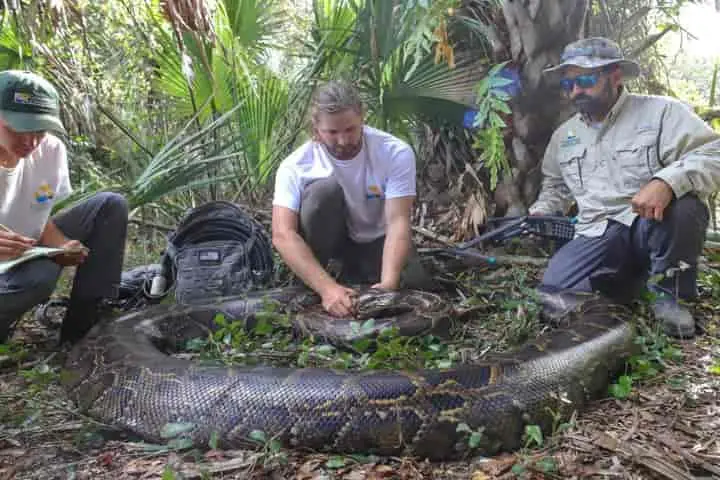

The invasive female Burmese python weighing 97 kilogram was caught by scientists in Florida (Pic. Courtesy smithsonianmag.com)
<p>
<strong>With the Burmese pythons &ndash; an invasive species — proliferating in Florida, the native species and the biodiversity are under severe strain and threat. The reason as per a report in smithsonianmag.com is that these reptiles have no natural predators in the region and have plenty of prey to satiate their hunger, thereby becoming bigger in size and more fertile too.</strong></p>
<p>
Recently, the scientists of Florida claimed that they caught the heaviest snake ever in Florida. The 18-foot-long female Burmese python was 215 pound in weight or 97 kilogram, who probably had eaten a white-tailed adult deer as her last meal. The biologists also discovered 122 eggs in the viper &ndash; a new record for a female python during a single breeding cycle. The average number of eggs is usually 43.</p>
<p>
<iframe allow="accelerometer; autoplay; clipboard-write; encrypted-media; gyroscope; picture-in-picture" allowfullscreen="" frameborder="0" height="315" src="https://www.youtube.com/embed/J63JC5k-BXQ" title="YouTube video player" width="560"></iframe></p>
<p>
The snake was tracked down by the scientists of a non-profit environmental group called Conservancy of Southwest Florida, which euthanised the creature humanely. The organisation is working to bring down the population of these invasive pythons in the Florida Everglades &ndash; a natural region of tropical wetlands which is located in southern part of Florida.</p>
<p>
The pythons essentially belong to southeast Asia and have made their presence felt in Florida&rsquo;s southwest area since 1979. The first one may have been a pet released by an owner or a one which had escaped as per Nature Conservancy.</p>
<p>
While it is not possible for scientists to confirm, many feel that the female captured may have been the original python that made it to the wild years ago according to Fort Myers News-Press.</p>
<p>
Flourishing in Everglades, the snakes have become a nuisance and problem for the ecosystem to the extent that scientists are now seeking help from people to hunt these creatures every August. Those who join the effort are also given prizes for capturing maximum number of these reptiles during a two-week stretch. In 2021 more than 600 people from 25 States joined this effort.</p>
<p>
<iframe allow="accelerometer; autoplay; clipboard-write; encrypted-media; gyroscope; picture-in-picture" allowfullscreen="" frameborder="0" height="315" src="https://www.youtube.com/embed/R-duTqrqh5M" title="YouTube video player" width="560"></iframe></p>
<p>
This initiative along with other efforts has proved beneficial as since 2013 more than 1,000 pythons have been removed from 100 sq mile region of southwest Florida.</p>
<p>
The last time scientists caught a huge python was in June 2021 and this female weighed 185 pounds.</p>
<p>
The biologists try to remove more reproductive females with the aim to upset the breeding cycle. To track and find these huge females, the scientists use a male snake called Dionysus or Dion who has a radio transmitter implanted in him. He led the team to this large female.</p>
<p>
In a statement, Ian Bartoszek who is a wildlife biologist with the Conservancy of Southwest Florida, said: &ldquo;How do you find the needle in the haystack? You could use a magnet and, in a similar way, our male scout snakes are attracted to the biggest females around.&rdquo;</p>
<p>
Following the capture of this female the researchers took her to the laboratory for necropsy and besides 122 eggs, they found hoof cores &ndash; pointing to the deer that the reptile had eaten.</p>
<p>
Working over the years, scientists have found in the stomach of the pythons caught various animals. These include 24 species of mammals, 47 types of birds and two species of reptiles. According to the US Geological Survey the pythons have led to the decline in the population of cottontail rabbits, marsh rabbits, racoons, foxes, bobcats and opossums, especially those which are located in the remote areas.</p>
<p>
<strong>Also read: <a href="https://www.indianarrative.com/science-news/drug-baron-pablo-escobar-s-cocaine-hippos-wreak-havoc-in-colombia-124459.html">Drug baron Pablo Escobar&rsquo;s Cocaine Hippos wreak havoc in Colombia</a></strong></p>
Prime Minister Narendra Modi arrived in Maldives on Friday as a part of his second…
The reduction in import duties on automobiles under the newly signed India-UK Free Trade Agreement…
Prime Minister Narendra Modi and his UK counterpart Keir Starmer shared a light moment during…
Prime Minister Narendra Modi lauded the signing of the landmark India-UK Free Trade Agreement on…
United Kingdom Prime Minister Keir Starmer on Thursday said that the UK-India FTA is the…
A Visiting Indian medical team on Thursday began treatment of patients injured in a fighter…